
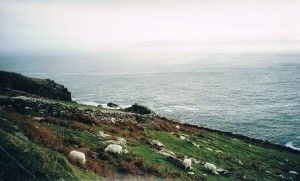
There are places we dream about before we’ve ever seen them. Such was the case for Ireland and me. For years, I’d have dreams about a land that was green and rocky, with rolling hills and coastal edges, cool and deeply mystical. When I finally saw these images in magazines and on television and knew them to be the Emerald Isle, I also knew I needed to go.
I grew up in an Irish town in the American Midwest, settled by immigrants who also experienced recognition upon seeing the green rolling hills, rivers and streams, the rural peacefulness. Kansas is not Ireland, but now having experienced both places, I see the similarities in the land and people and understand why those Irish folks long ago, most banished or desperately fleeing their troubled and beloved homeland, hit the brakes at what they considered familiar.
I’m sure most of the Irish who traveled to the U.S. during the potato famine – including some of my ancestors – felt they had no choice. My choice to go to Ireland nearly ten years ago had a lot to do with returning on their behalf and to fulfill seeing in person those dreams I had had that were perhaps genetic memories trickling through in my own DNA.
My ‘return’ to Ireland came in a roundabout (hey, that sounds very Irish) way. I decided to run a marathon in Dublin, thus fulfilling two “bucket list†items. It took six months of training, one torn knee ligament and raising nearly $5,000 for the American Diabetes Association to manage the trip. It was deliberately arduous, but given what my forebears had endured, it was a walk in the park.
 My first glimpse of Ireland came from the air and it was sheer recognition. I felt the tears come as I looked down upon the sparkling water against the ragged rocky-green coast. Two days later, I was running the streets of Dublin in the marathon. I’ll be modest with the details of the 26.2 mile race…I didn’t set any records, but I did (thankfully) come in before the guy on stilts. I ran the last half-mile with tears streaming down my cheeks. They say those near death have their lives flash before their eyes. I say those in the final throes of a marathon – full of life — experience the same thing, all life moments culminating, so the emotions eclipse. It was one of the best days of my life.
My first glimpse of Ireland came from the air and it was sheer recognition. I felt the tears come as I looked down upon the sparkling water against the ragged rocky-green coast. Two days later, I was running the streets of Dublin in the marathon. I’ll be modest with the details of the 26.2 mile race…I didn’t set any records, but I did (thankfully) come in before the guy on stilts. I ran the last half-mile with tears streaming down my cheeks. They say those near death have their lives flash before their eyes. I say those in the final throes of a marathon – full of life — experience the same thing, all life moments culminating, so the emotions eclipse. It was one of the best days of my life.
Having satisfied one of my big “to-do’s,†I moved on to another. Ireland, even in late October and early November, glowed so green it hurt my eyes. It did look familiar, but it also felt foreign. Where else would you ever see little boys – looking like small adults – serving marathoners tea out of china cups and saucers? Would you imagine In America children and dogs and all manner of people walking their towns and neighborhoods after dark? Or that the fuel for heat – peat – is still cut from the bogs and smells like burning leaves. And the sheep – everywhere, dotting the green hillsides like white flowers.
But the people – all ages – and even the dogs and even the sheep, while friendly and curious and helpful, don’t go out of their way to impress you or demand a pat on the head or the back. And they don’t hand those out freely, either. The Irish admonishment of accomplishment is a modest “Well done.†If you expect a stroking of your large American ego, you better go elsewhere.
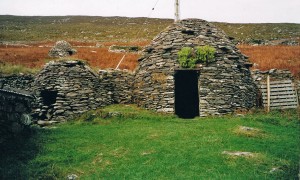 After my own “well-done†self back-patting upon completing the marathon, I ventured off to travel the southern part of the country on my own. Since this is a food blog, I will remain focused (somewhat), though it’s tempting to tell you about getting locked in the high-walled garden of a manor house on Halloween or that I explored a towering ancient fortress called The Rock of Cashel or stood on the most western point of Europe viewing the Atlantic Ocean or that I stepped inside a monastic beehive stone hut several hundred years old or heard the odd and medieval-like Gaelic language spoken to me by a man who thought I was an Irish native or how I saw my first real live holly tree in a beautiful forest park I walked through in Killarney or how I gathered sand and dirt in small jars to carry home.
After my own “well-done†self back-patting upon completing the marathon, I ventured off to travel the southern part of the country on my own. Since this is a food blog, I will remain focused (somewhat), though it’s tempting to tell you about getting locked in the high-walled garden of a manor house on Halloween or that I explored a towering ancient fortress called The Rock of Cashel or stood on the most western point of Europe viewing the Atlantic Ocean or that I stepped inside a monastic beehive stone hut several hundred years old or heard the odd and medieval-like Gaelic language spoken to me by a man who thought I was an Irish native or how I saw my first real live holly tree in a beautiful forest park I walked through in Killarney or how I gathered sand and dirt in small jars to carry home.
No, this is about food, and for that Ireland has its own unique charms. While there, I ate my way along, dining on all from convenience store snacks, pub grub and high-end cuisine.
Firstly, I must highlight Ireland’s dairy products, which are supreme. The only way they could be fresher would be if the cow were standing nearby. I’ve never had yogurt so creamy and flavorful (nor containing such Irish-known ingredients as rhubarb and gooseberries – more on those soon). The butter was outstanding and served by the bowlful. And cream! Cream is always served with tea (do try this sometime…the cream tempers the tea to an almost floral flavor) and tea is consumed more than coffee – I gave servers pause whenever I ordered coffee.
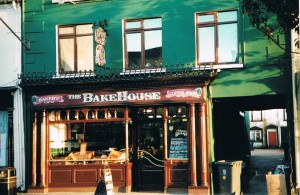 And to highlight a few more food anomalies of Ireland that might give you pause: cookies are called biscuits; cupcakes are called muffins, strips of bacon (which really more resembles ham) are called rashers, potato chips are called crisps, one popular brand going by the delightful name of “Hunky Dorysâ€; and on package labels nutritional values list “sugar†content as “energy.†The little towns have butcher shops where the men behind the counter wear little white derby hats. The bakeries and restaurants are often two-story establishments with the more businesslike transactions – like bread and beer — taking place on the street level and leisurely dining/taking tea or coffee occurring upstairs. It was on the second story of one such venue that, feeling very Irish (having just purchased some woolen wear), I ordered myself some very traditional foods – Irish stew and colcannon. I had made colcannon before – a hearty mix of potatoes, cabbage and onions mashed to a substantial consistency. My order of the dish arrived in a huge bowl, as did the Irish stew.
And to highlight a few more food anomalies of Ireland that might give you pause: cookies are called biscuits; cupcakes are called muffins, strips of bacon (which really more resembles ham) are called rashers, potato chips are called crisps, one popular brand going by the delightful name of “Hunky Dorysâ€; and on package labels nutritional values list “sugar†content as “energy.†The little towns have butcher shops where the men behind the counter wear little white derby hats. The bakeries and restaurants are often two-story establishments with the more businesslike transactions – like bread and beer — taking place on the street level and leisurely dining/taking tea or coffee occurring upstairs. It was on the second story of one such venue that, feeling very Irish (having just purchased some woolen wear), I ordered myself some very traditional foods – Irish stew and colcannon. I had made colcannon before – a hearty mix of potatoes, cabbage and onions mashed to a substantial consistency. My order of the dish arrived in a huge bowl, as did the Irish stew. 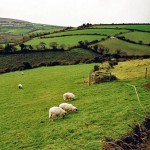 Here, I admit to a food faux pas. I had forgotten the main element of Irish stew, and as I began eating, it slowly dawned on me. “This beef tastes a little gamey,†thought I, then the realization – it’s mutton. So, my apologies to tradition (and my momentary lapse of intelligence), but I subsisted on colcannon for that meal.
Here, I admit to a food faux pas. I had forgotten the main element of Irish stew, and as I began eating, it slowly dawned on me. “This beef tastes a little gamey,†thought I, then the realization – it’s mutton. So, my apologies to tradition (and my momentary lapse of intelligence), but I subsisted on colcannon for that meal.
Surprisingly the worst thing I ate in Ireland was a scone. We had stopped in the town Dingle on a tour of the Dingle peninsula, when I was lured into the intriguing Dingle Tearooms (plural). I expected a quaint place laden with doilies, but instead found a hopping cafeteria-like atmosphere. I could not resist ordering a scone, figuring it would be close to idyllic version of that pastry.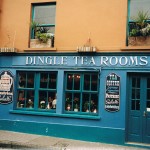 It was not, and I don’t fault the scone or its maker. I am sure it was made in the Irish tradition and not the Americanized sweeter, richer version. This Irish scone was very plain, dry and full of raisins. It was also cold since I had ordered it later in the day. I’m sure hot and slathered with butter it would have been better (as most things are).
It was not, and I don’t fault the scone or its maker. I am sure it was made in the Irish tradition and not the Americanized sweeter, richer version. This Irish scone was very plain, dry and full of raisins. It was also cold since I had ordered it later in the day. I’m sure hot and slathered with butter it would have been better (as most things are).
Irish eating in Ireland goes beyond corned beef and cabbage – the typical St. Patrick’s Day go-to dish. What stood out most in my Irish eating experiences was the Irish breakfast– prevalent, predominant and nearly identical everywhere I stayed, from the most elegant manor to the most homey and inexpensive bed and breakfast. This meal was so replicated and so recurring on my plate each morning, that I thought, at times, I must be living out a real-life version of the movie “Groundhog Day.†Here are, nearly without fail, the components of an Irish breakfast:
Two rashers of bacon – as mentioned previously, this is meaty bacon, very lean and more like ham.
Two link sausages
Two eggs – usually fried over easy.
Hash browns.
Two small broiled tomato halves.
Black and white pudding – the first time I tried this, I thought it was a sausage patty. I was sorely mistaken. This creature is an acquired taste, I’m sure. Also known as “blood†pudding, it is made of blood (pig, sheep, cow) mixed with some type of filler like suet. I found it to be rather bland – not my cup of tea.
Brown bread – very dense, dark and hearty, this is an Irish staple with many meals. It is sometimes served warm or toasted, with a bowl of “dobs†of butter nearby.
A pot of tea or coffee and a pitcher of cream. Oatmeal or porridge was also sometimes a part of the Irish breakfast. 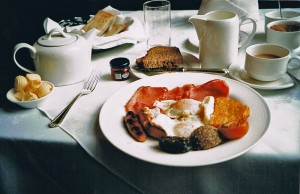
Obviously, the Irish have held fast to the notion that one must start the day eating like a king, lunch like a prince and dinner like a pauper. That opening meal usually had to fuel a long day of physical work. The brown bread alone would carry you far (even though a loaf of the stuff would be hard to carry). Many folks make soda bread on St. Patrick’s Day (as have I), but I find the yeast brown bread an appealing tradition.
The recipe I found from Saveur magazine a few years back seemed to most match that bread I had on the Emerald Isle. It is quite traditional and very simple: it mixes up easy and rises well. With five cups of flour per loaf, you can imagine the weighty density of this surprisingly tasty bread. I love that the recipe has an old-school type of method of warming the flour in the oven prior to mixing in the proofed yeast and warm water. And then, that mixing is done with your two bare hands. Feeling that warm fleshy dough is like holding something alive. The bread bakes up in a nice crusty loaf with a nutty, wheaty flavor. Given that this bread is made with whole-wheat flour and has no fat in it, you can feel virtually guilt-free when you slather it with butter (why not try butter imported from Ireland…Kerrygold is now available in many major supermarkets.) 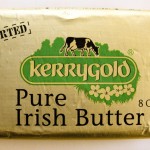
I hope to return to Ireland someday, probably not via a race, though I won’t rule that out. Try a race yourself or a take trip you’ve always wanted or stir up a batch of brown bread to honor this faraway place. And upon completion of any of these endeavors, pat yourself on the back and say, “Well done!â€
Doris Grant’s Brown Bread
From Saveur magazine
Makes 2 5†by 8-1/2†loaves
“Myrtle Allen, founder of the famed Irish restaurant Ballymaloe, invented this recipe from a simple no-knead, one-rise bread developed at the request of the British government during World War II by English cookbook writer Doris Grant. After she started serving it at Ballymaloe, it became popular all over Ireland.â€
1 tbsp. butter
2 7-gram packets active dry yeast
2 tbsp. black treacle
10 cups stone-ground whole wheat flour
1 1â„2 tbsp. fine sea salt
1. Preheat oven to 200°. Grease two 5″ × 81/2″ loaf pans with butter and set them aside in a warm spot. Put yeast into a small glass bowl, add treacle and 1/2 cup lukewarm water, and stir to dissolve. Set aside and let rest until yeast bubbles and becomes frothy, about 10 minutes.
2. Put flour and salt into a large ovenproof bowl and stir well to combine. Place bowl in oven and let rest until flour mixture is warmed through, about 10 minutes. Remove bowl from oven, add the yeast mixture and 3 1/2 cups lukewarm water, and mix together with your hands until well combined and a sticky dough forms.
3. Increase heat to 400°. Divide dough evenly between the 2 prepared loaf pans, cover with a clean kitchen towel, and let rise in a warm spot until bread has grown by one-third, 15–20 minutes. Bake bread on middle rack of oven until the loaves are browned on top, about 45 minutes. Loosely cover loaves with foil, then continue to bake for 25–30 minutes more.
4. Let bread cool in pans for 10 minutes, then gently run a table knife around inside edges of pans to loosen. Turn loaves out onto a rack and let rest until completely cool, 2–3 hours.
Blogger’s Note: I substituted molasses for the treacle (which may be hard to find), and I cut this recipe in half for one loaf. It worked just fine!
